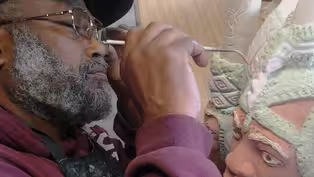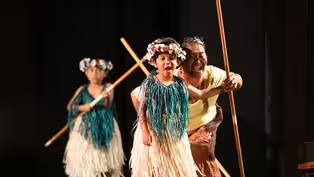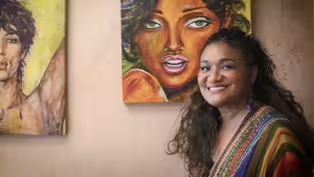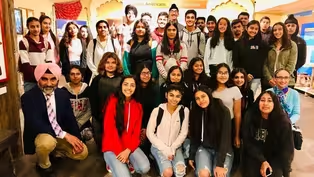KVIE Digital Studios
Pamela J. Peters | Preserving Culture Through Art
7/2/2021 | 6m 42sVideo has Closed Captions
Multimedia Artist Pamela J Peters describes her work as Indigenous Realism.
Multimedia Artist Pamela J Peters describes her work as Indigenous Realism. Using her art as a vessel to tell the stories, preserve the legacy, dedication, resilience, contributions, and lives of Native Americans.
Problems playing video? | Closed Captioning Feedback
Problems playing video? | Closed Captioning Feedback
KVIE Digital Studios is a local public television program presented by KVIE
Episode funded in part by the California Arts Council, a state agency.
KVIE Digital Studios
Pamela J. Peters | Preserving Culture Through Art
7/2/2021 | 6m 42sVideo has Closed Captions
Multimedia Artist Pamela J Peters describes her work as Indigenous Realism. Using her art as a vessel to tell the stories, preserve the legacy, dedication, resilience, contributions, and lives of Native Americans.
Problems playing video? | Closed Captioning Feedback
How to Watch KVIE Digital Studios
KVIE Digital Studios is available to stream on pbs.org and the free PBS App, available on iPhone, Apple TV, Android TV, Android smartphones, Amazon Fire TV, Amazon Fire Tablet, Roku, Samsung Smart TV, and Vizio.
Providing Support for PBS.org
Learn Moreabout PBS online sponsorshipMore from This Collection
Akinsanya Kambon | Preserving Culture Through Art
Video has Closed Captions
Artist Akinsanya Kambon hopes through his art to inspire others. (7m 5s)
TeAda Productions | Preserving Culture Through Art
Video has Closed Captions
TeAda Productions extends an outlet of service, education and creative courage. (6m 8s)
Artist Dr. Monica Crooks | Preserving Culture Through Art
Video has Closed Captions
Meet artist and dentist Dr. Monica Crooks. (6m 4s)
Punjabi American Heritage Society
Video has Closed Captions
See how the Punjabi American Heritage Society is preserving culture through art. (5m 8s)
Providing Support for PBS.org
Learn Moreabout PBS online sponsorship♪♪ Pamela: I think to be seen as native American here in contemporary times is, is vital for our existence, really because it affects not only our imagery, but it all also affects policies.
It also affects our land base.
Marinda: Multimedia Artist Pamela J Peters describes her work as Indigenous Realism.
Using her art as a vessel to tell the stories, preserve the legacy, dedication, resilience, contributions, and lives of Native Americans.
While also building a foundation to dismantle the false and harmful narratives used for far too long.
Pamela: I was born and raised on a tribal reservation.
I was born in, um, in Shiprock New Mexico, which is on the Navajo nation...
When I would spend time with my father, um, he really enjoyed watching Western films... And, um, so these Western films I've always saw how they depict Indians and how Indians were seen as savages as, um, You know, almost like this demonic being in their storytelling and I'm watching it.
And I felt weird even as a young kid.
And then I saw my dad, he jumped up and he was like cheering for John Wayne.
And he's like, yeah, kill the Indians.
And I was like, Wait a minute.
What does that mean?
And as a young kid, that confused me and I was a bit precousious I was like, why did they want to kill the Indians?
And this is my dad saying, because they're bad.
And I'm like, but aren't we Indians?
He's like, well, we're not like them.
And I couldn't understand that.
Marinda: Pamela would carry the weight of that narrative throughout her life.
Leaving her in search of where she fit into the world around her and how she would define herself as a Native American.
Pamela: ...Fast forward when I was, um, going to school at UCLA and I was, um, studying American Indian history and I was also studying film and television history.
So I kind of combined my focus on both aspects and it really like clicked with me like, Oh, This is why they did this.
This is why they created this good character and this bad character, because, and this is why they created Western ideology is they needed to get society to understand, well, these are the reasons why we've decimated Indians is because we needed the land base.
And what other great way to do this is through Western films.
Pamela: And we were completely erased of understanding the realness of who we are in the education system.
So there was this mockery that's created through sports events and through, um, Um, advertisements.
And so when I really understood that, I'm like, well, this is why I was a confused, um, young kid and why I became a rebellion teenager.
And why I felt suicidal, um, later in my teens.
And I think a lot of young kids feel that way because they don't see themselves.
Marinda: In finding her own understanding.
Pamela embraced her Native American roots, creating cultural outlets through her art.
And establishing a platform for others to be seen and see themselves, authentically.
The Mural of Toypcirina in Indian Alley, We Hear you!
Pamela: Well, I think it's important.
The work that I'm doing, it is preserving, it's preserving a narrative at the time.
I definitely think that art builds connection to understanding other cultures definitely.
I think my work has definitely, um, opened people subconscious mind to say, Oh, I didn't know.
I didn't know the, the history of American Indians in the city.
I didn't know that there were 567 federally recognized tribes...
I definitely think it does and it gives it.
It gives existence to the atrocities of our history... Marinda: Pamela'’s work has also given many of its viewers a resilience to take a deeper look at their own understanding of how they may subconsciously view others through a biased lens.
While also giving opportunities to ask questions.
Pamela: ...I think what people can understand with native American culture is that we are just not one image.
♪♪ So for right now I'm just kind of, um, Documenting, um, the existence of who we are as contemporary American Indians today.
Pamela: I hope people will gain from just seeing my work and hearing my films and my poetry is.
That they can make a conscious decision with the choices they make in life.
And to really understand the diversity of American Indians were not one Relic Indian.
We do have multiple voices.
We are the fabric of the United States.
I'm just a small, small fraction of the many stories that can be told.
Um, I think everybody has this creative ability to do it.... And I hope I can carry that, you know, pass on that torch to the next person.
Today I live with pride.
Today I live with pride.
Today I live with pride.
Support for PBS provided by:
KVIE Digital Studios is a local public television program presented by KVIE
Episode funded in part by the California Arts Council, a state agency.

















